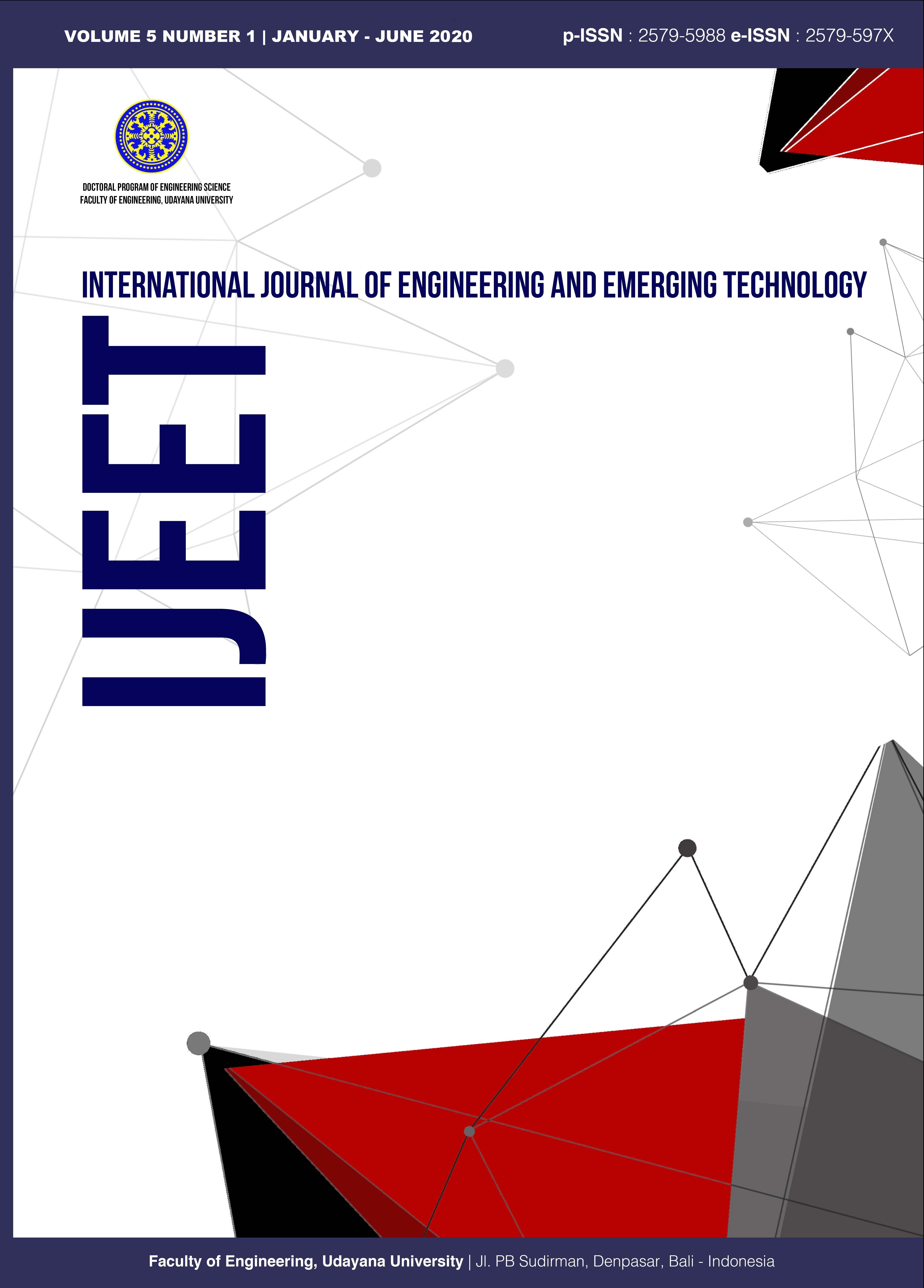DRILLING GROUNDWATER FOR RAW WATER IN SEMBIRAN VILLAGE,TEJAKULA DISTRICTS, BULELENG REGENCY
Abstract
ABSTRACT- Water is an absolute necessity that must be met, both for drinking water and for irrigation. An alternative to meet the water needs other than rainwater or surface water, is by taking underground water by drilling deep wells. Sembiran Village is a village located in Tejakula District, Buleleng Regency, the village is a dry area that requires water, both for drinking water and for agriculture. Location of groundwater drilling including Tejakula groundwater basin. In order to achieve the above objectives, an effective and efficient groundwater drilling technique should be carried out considering that the area geologically has rocks dominated by volcanic lava rock which are the products of Mount Agung and Mount Buyan Beratan Purba. The method of drilling groundwater is carried out in stages starting from drilling a Pilot Hole with a diameter of 6 to 64 meters, followed by an enlargement of 8 ", 10" to 12 "drill holes to a depth of 64 meters. In the field of drilling work the Hydrolic Rotary System Method, Direct Circulation Rotary Drilling is used and for the removal of cutting / dirt mud Fludia is used. The equipment used for drilling is rotary / skid mounted drilling machines with a capacity of up to ± 150.0-200.0 meters, equipped with equipment such as: mud pumps, a series of equipment that cannot be separated from one another. For well logging an Electrical logger is used for geophysical wellbore investigations. For the work of washing wells using compressor and other supporting equipment. Pumping the test uses a submersible pump that has a minimum discharge capability of 10 lt / sec and a maximum of 20 lt / sec. The results of direct observations and measurements of the physical parameters of the Sembiran Village Drilling Well (SEM-5) contain TDS = 219.; PH = 7.0. Chemically, Iron (Fe) = 0.001 mg/ltr; Arsenic (Ar) = 0.067 mg/ltr; Availability (CACO3) = 56.4 mg/ltr; Chloride (Cl-) = 91.6 mg/ltr; Nitrate (N) = 0.013 mg/ltr; Sulfate (SiO4) = 1.88 mg); Lead (Pb) = 0 mg/ltr; organic matter (KMnO4) = 0.34 mg/ltr, so the Drilling wells (SEM-5) meet clean water quality standards based on the Regulation of the Minister of Health of the Republic of Indonesia Number 492 / Menkes / Per / IV / 2010. Discharge obtained from pumping test results at SEM-5 wells is 20.47 liters/sec with surface water level(swl) = 23.60 m, and the position of the pump is placed at 42 m from the ground surface.
Downloads
References
[1] Arifin, L., & Ilahude, D. (2016). Penafsiran Geologi Perairan Pulau Menjangan-Bali Dari Data Seismik. Jurnal Geologi Kelautan, 2(3). https://doi.org/10.32693/jgk.2.3.2004.116
[2] Amri, H., & Amri, S. (2018). Implementasi Teknologi Pengolahan Air Tanah Artesis Menjadi Air Layak Minum Di Desa Buruk Bakul. Dikemas (Jurnal Pengabdian Kepada Masyarakat). https://doi.org/10.32486/jd.v2i1.256
[3] Baiti, H., Siregar, S. S., & Mangkurat, U. L. (2016). Aplikasi Well Logging untuk Penempatan Pipa Saringan Sumur Bor Air Tanah di Desa Banyu Irang Kecamatan Bati-Bati, Kalimantan Selatan. Jurnal Fisika FLUX.
[4] Chaudhari, A., Malarvizhi, S., Woon, K. S., Senthil Kumar, A., & Rahman, M. (2015). The effects of pilot hole geometry on tool-work engagement efficacy in deep hole drilling. Journal of Manufacturing Processes, 19, 135–141. https://doi.org/10.1016/j.jmapro.2015.06.006
[5] Ginting, S., & Rengganis, H. (2010). Pemodelan Air Tanah di Cekungan Air Tanah Umbulan dengan Visual Modflow Premium 4.3. Jurnal Sumber Daya
[6] Houben, G. J. (2015). Review: Hydraulics of water wells—flow laws and influence of geometry. Hydrogeology Journal. https://doi.org/10.1007/s10040-015-1312-8
[7] H., T., & T., S. (2012). Simulasi Aliran Air Tanah Cekungan Air Tanah Denpasar-Tabanan, Provinsi Bali Simulation of Groundwater Flow, Denpasar-Tabanan Groundwater Basin, Bali Province. Indonesian Journal on Geoscience.
[8] Khaki, M., Yusoff, I., & Islami, N. (2014). Groundwater quality assessment of a freshwater wetland in the Selangor (Malaysia) using electrical resistivity and chemical analysis. Water Science and Technology: Water Supply. https://doi.org/10.2166/ws.2013.196
[9] Lan, Y., Jin, M., Yan, C., & Zou, Y. (2015). Schemes of groundwater exploitation for emergency water supply and their environmental impacts on Jiujiang City, China. Environmental Earth Sciences. https://doi.org/10.1007/s12665-014-3586-x
[10] Manullang, D. F., & Siregar, N. (2019). Identifikasi Kejernihan Air Sumur Bor Ditinjau Dari Daya Hantar Listrik (Dhl) Dengan Konduktivitimeter Di Desa Sentang Kecamatan Teluk Mengkudu Kabupaten Serdang Bedagai. Einstein E-Journal. https://doi.org/10.24114/einstein.v6i2.12077
[11] Maria, R. (2008). Hidrogeologi dan Potensi Resapan Air Tanah Sub Das Cikapundung Bagian Tengah. Jurnal RISET Geologi Dan Pertambangan. https://doi.org/10.14203/risetgeotam2008.v18.13
[12] Nimmo, J. R., Healy, R. W., & Stonestrom, D. A. (2005). Aquifer Recharge. In Encyclopedia of Hydrological Sciences. https://doi.org/10.1002/0470848944.hsa161a
[13] Nurhasanah, Sihombing, L., & Lapanporo, B. P. (2016). Pemetaan Sebaran Kandungan pH, TDS, dan Konduktivitas Air Sumur Bor (Studi Kasus Kelurahan Sengkuang Kabupaten Sintang Kalimantan Barat). Prisma Fisika.
[14] Prasetyawati Umar, E., & Nawir, A. (2018). Potensi Airtanah Dangkal Dalam Pemenuhan Kebutuhan Air Bersih Kota Makassar. Jurnal Geomine. https://doi.org/10.33536/jg.v6i2.215
[15] Pujianiki, N. N., & Simpen, I. N. (2018). Aplikasi Geolistrik pada Pemetaan Daerah Intrusi Air Laut di Pantai Candidasa. MEDIA KOMUNIKASI TEKNIK SIPIL. https://doi.org/10.14710/mkts.v24i1.17574
[16] Sudinda, T. W. (2020). Simulasi Potensi Air Tanah Pulau Padang Riau Dengan Visual Modflow. Jurnal Air Indonesia, 11(2). https://doi.org/10.29122/jai.v11i2.3940
[17] Sethi, R., & Di Molfetta, A. (2019). Well Testing. In Springer Tracts in Civil Engineering. https://doi.org/10.1007/978-3-030-20516-4_5
[18] Subagyono, K., Haryati, U., & Talaohu, S. H. (2004). Teknologi konservasi air pada pertanian lahan kering. Teknologi Konservasi Tanah Pada Lahan Kering Berlereng.

 Indexed By
Indexed By







